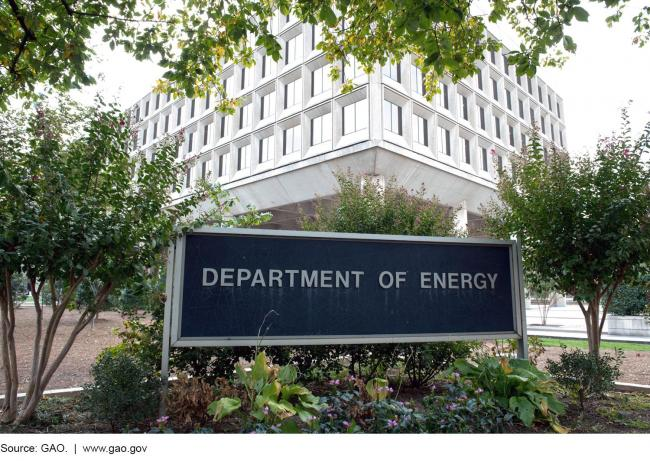Department of Energy: Continued Actions Needed to Address Management Challenges
Fast Facts
The Department of Energy's National Nuclear Security Administration manages the U.S. nuclear weapons stockpile and supports nonproliferation efforts. DOE's Office of Environmental Management addresses contamination at nuclear weapons production sites. We testified that
NNSA hasn’t aligned budgets with plans to modernize its nuclear weapons, which raises affordability concerns
NNSA has faced problems implementing its nonproliferation programs
DOE continues to face challenges managing its contracts and projects (e.g. for cleanup and weapons programs)
DOE's environmental cleanup responsibilities may cost billions more than anticipated

Photograph of the Department of Energy.
Highlights
What GAO Found
The Department of Energy's (DOE) National Nuclear Security Administration (NNSA) faces challenges related to the affordability of its nuclear modernization programs. GAO found in April 2017 that these challenges were caused by a misalignment between NNSA's modernization plans and the estimated budgetary resources needed to carry out those plans. First, GAO found that NNSA's estimates of funding needed for its modernization plans sometimes exceeded the budgetary projections included in the President's planned near-term and long-term modernization budgets. Second, GAO found that the costs of some major modernization programs—such as for nuclear weapon refurbishments—may also increase and further strain future modernization budgets that currently do not anticipate these potential increases. GAO recommended in April 2017 that NNSA include an assessment of the affordability of its modernization programs in future versions of its annual plan on stockpile stewardship; NNSA neither agreed nor disagreed with that recommendation.
DOE has taken several important steps that demonstrate its commitment to improving contract and project management, but challenges persist. In recent reports, GAO has noted progress as DOE has developed and implemented corrective actions to identify and address root causes of persistent project management challenges and progress in its monitoring of the effectiveness and sustainability of corrective actions. However, DOE's recent efforts do not address several areas of contract and project management where the department continues to struggle. GAO has made several recommendations related to these issues, many of which DOE has not yet implemented.
DOE also faces challenges with addressing its environmental liabilities—the total cost of its cleanup responsibilities. In February 2017, GAO found that DOE was responsible for over 80 percent ($372 billion) of the U.S. government's estimated $450 billion environmental liability. However, this estimate does not reflect all of DOE's cleanup responsibilities. For example, in January 2017, GAO found that the cost estimate for DOE's proposal for separate defense and commercial nuclear waste repositories excluded the costs and time frames for key activities, and therefore full costs are likely to be billions of dollars more than DOE's reported environmental liabilities. To effectively address cleanup, GAO and other organizations have reported that DOE needs to take a nation-wide, risk-informed approach, which could reduce long-term costs as well as environmental risks more quickly. Since 1994, GAO has made at least 28 recommendations to address the federal government's environmental liabilities and 4 suggestions to Congress to consider changes to the laws governing cleanup activities. Of these, 13 recommendations remain unimplemented.
Finally, NNSA faces challenges in implementing its nonproliferation programs. For example, in June 2016, GAO found that NNSA's Nuclear Smuggling Detection and Deterrence program had developed a program plan, but NNSA could not measure progress because not all of the program's goals were measurable, and performance measures were not aligned with the goals. As a result, NNSA may not be able to determine when the program has fully achieved its mission. GAO has made several recommendations related to NNSA's nonproliferation programs, some of which NNSA has yet to implement.
Why GAO Did This Study
DOE's NNSA is responsible for managing the nuclear weapons stockpile and supporting nuclear nonproliferation efforts. DOE's Office of Environmental Management's mission includes decontaminating and decommissioning facilities that are contaminated from decades of nuclear weapons production.
Over the last few years, GAO has reported on a wide range of challenges facing DOE and NNSA. These challenges contribute to GAO's continuing inclusion of DOE's and NNSA's management of major contracts and projects on the list of agencies and program areas that are at high risk of fraud, waste, abuse, and mismanagement, or are in need of transformation. GAO also recently added the U.S. government's environmental liabilities to this list.
This statement is based on 13 GAO reports issued from May 2015 through May 2017 and discusses (1) challenges related to the affordability of NNSA's nuclear modernization plans, (2) the status of DOE's efforts to improve its management of contracts and projects, (3) challenges in addressing DOE's environmental liabilities, and (4) challenges facing NNSA's nonproliferation programs.
Recommendations
GAO is not making any new recommendations in this statement. GAO has suggested that Congress consider taking certain actions and that DOE continue to act on the numerous recommendations made to address these challenges. GAO will continue to monitor DOE's implementation of these recommendations.
